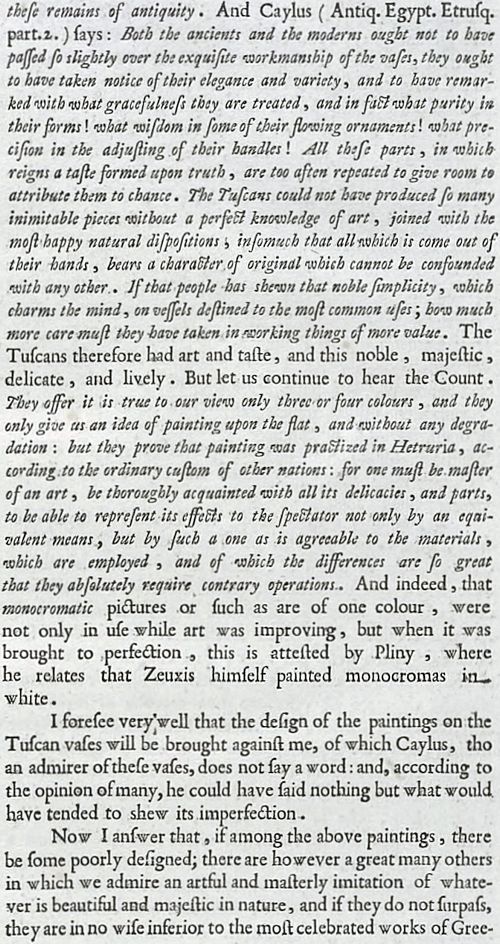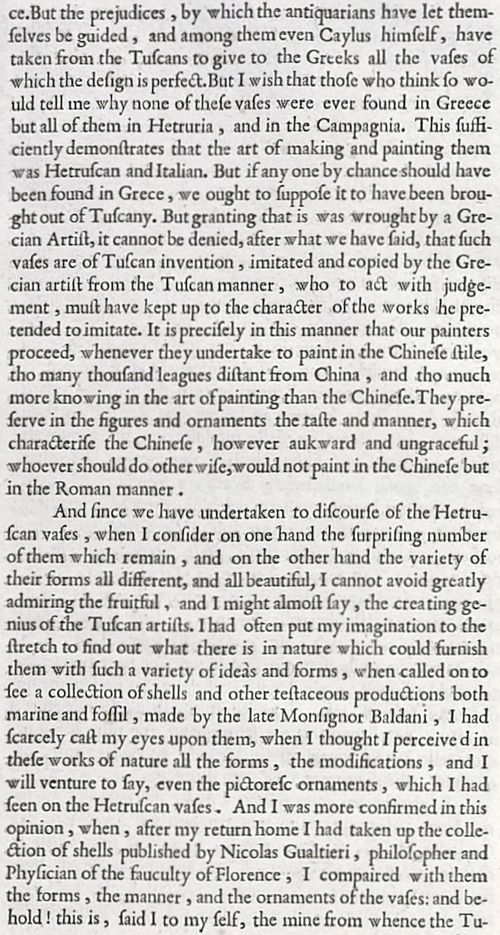
And in the first place I ask whether all those works which are commonly reputed to be Tuscan be such in reality. God forbid I should detract any thing from the merit of the illustrious author of the Tuscan Museum. I know how much the republic of letters, and the Tuscan learning in particular owe to his labours: but I will however venture to say, that in his great collection there are many things which the Tuscans would not
acknowledge for their own notwithttanding the protestations of Gori. I will say that if all those, which have no other character of Tuscan but their having been found in Etruria, or being rude, and ill-made, were to be taken away; the work, it is true, would diminish in size, but would perhaps increase in value. But be this as it will, I maintain that we ought not to judge of the excellence of the Tuscan artists unless from works which are undoubtedly Tuscan. Now these, tho they were even all of a strong and stiff character, are in so small a number, that without a most partial blindness they are not sufficient to decide of the ignorance or incapacity of the Tuscans. And had the Grecian artists the exclusive priviledge of making nothing either in painting or sculpture but what was perfect? And did nothing ever come from them that was strong and stiff? In which case it ought be said that a number of middleing works, and many of no kind of merit, which yet remain in Greece, were made by the Tuscans.
But are the Tuscan ornaments in fact all of this character. And among so many is there not one to be found to give a more advantageous idea of the skill of their artists? Let us give ear to the Marquis Scipio Maffei, and to Count Caylus, who will answer for me: How excellent, says the first, were the Tuscans in the working of metals and clay, is evident from their monuments: the statue dressed in the toga in the museum of the Medici, the chimera of most beautiful metal, and many other works, cast hollow and executed in the greatest perfection, evidently demonsrate their ability in it, and in another place; the design of these vases, of the statues, and other ornaments is generally very excellent, tho there are not wanting even some of rude workmanship, which probably were the first and most ancient, there are some however nothing inferior to the Grecian. This people signalized it self in regard of design, and in those arts which depend on it. The knowledge of the Tuscans in architecture is evident from the many ornaments attributed afterwards not to the Tuscan, but to the other orders, and it shines forth in the doors, in the little temples, or altars, and chapels, which are desined on some of
| |

these remains of antiquity. And Caylus (Antiq. Egypt. Etrusq. part.2.) says: Both the ancients and the moderns ought not to have
passed so slightly over the exquisite workmanship of the vases, they ought to have taken notice of their elegance and variety, and to have remarked with what gracefulness they are treated, and in fact what purity in their forms! What wisdom in some of their flowing ornaments! What precision in the adjusting of their handles! All these parts, in which reigns a taste formed upon truth, are too often repeated to give room to
attribute them to chance. The Tuscans could not have produced so many inimitable pieces without a perfect knowledge of art, joined with the
most happy natural dispofitions, in so much that all which is come out of their hands, bears a character of original which cannot be confounded
with any other. If that people has shown that noble simplicity, which charms the mind, on vessels defined to the most common uses; how much more care must they have taken in working things of more value. The Tuscans therefore had art and taste, and this noble, majestic, delicate, and lively. But let us continue to hear the Count. They offer it is true to our view only three or four colors, and they only give us an idea of painting upon the flat, and without any degradation: but they prove that painting was practised in Hetruria, according to the ordinary custom of other nations: for one must be master of an art, be thoroughly acquainted with all its delicacies, and parts, to be able to represent its effects to the spectator not only by an equivalent means, but by such a one as is agreeable to the materials, which are employed, and of which the differences are so great that they absolutely require contrary operations. And indeed, that monochromatic pictures or such as are of one color, were not only in use while art was improving, but when it was brought to perfection, this is attestied by Pliny, where he relates that Zeuxis himself painted monochromes in white.
I foresee very well that the design of the paintings on the Tuscan vases will be brought against me, of which Caylus, tho an admirer of these vases, does not say a word: and, accordino to the opinion of many, he could have said nothing but what would have tended to show its imperfection.
Now I answer that, if among the above paintings, there be some poorly designed; there are however a great many others in which we admire an artful and masterly imitation of whatever is beautiful and majestic in nature, and if they do not surpass, they are in no wise inferior to the most celebrated works of Greece.
| |

But the prejudices, by which the antiquarians have let themselves be guided, and among them even Caylus himfelf, have taken from the Tuscans to give to the Greeks all the vases of which the design is perfect. But I wish that those who think so would tell me why none of these vases were ever found in Greece but all of them in Hetruria, and in the Campagnia. This sufficiently demonstrates that the art of making and painting them
was Hetruscan and Italian. But if any one by chance should have been found in Grecce, we ought to suppose it to have been brought out of Tuscany. But granting that is was wrought by a Grecian artist, it cannot be denied, after what we have said, that such vases are of Tuscan invention, imitated and copied by the Grecian artist from the Tuscan manner, who to act with judgement, must have kept up to the character of the works he pretended to imitate. It is precisely in this manner that our painters proceed, whenever they undertake to paint in the Chinese style, tho many thousand leagues distant from China, and tho much more knowing in the art of painting than the Chinese.They preserve in the figures and ornaments the taste and manner, which characterize the Chinese, however awkward and ungraceful; whoever should do other wise, would not paint in the Chinese but in the Roman manner.
And since we have undertaken to discourse of the Hetruscan vases, when I consider on one hand the surprising number of them which remain, and on the other hand the variety of their forms all different, and all beautiful, I cannot avoid greatly admiring the fruitful, and I might almost say, the creating genius of the Tuscan artists. I had often put my imagination to the stretch to find out what there is in nature which could furnish
them with such a variety of ideas and forms, when called on to see a collection of shells and other testaceous productions both marine and fossil, made by the late Monsignor Baldani, I had scarcely cast my eyes upon them, when I thought I perceived in these works of nature all the forms, the modifications, and I will venture to say, even the picturesque ornaments, which I had seen on the Hetruscan vases. And I was more confirmed in this opinion, when, after my return home I had taken up the cohesion of shells published by Nicolas Gualtieri, philosopher and
physician of the fauculty of Florence, I compared with them the forms, the manner, and the ornaments of the vases: and behold! This is, said I to myself, the mine from whence the Tuscans
|